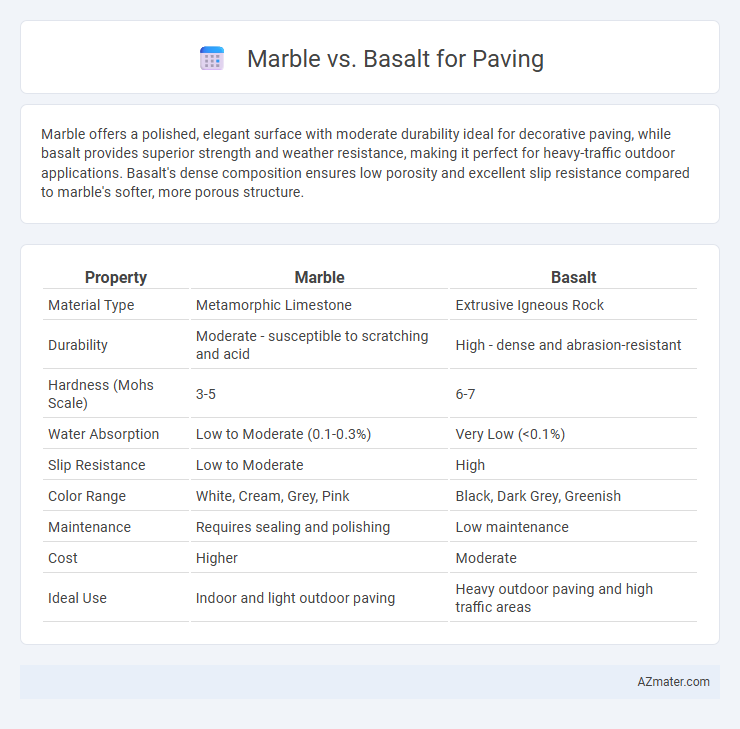Marble offers a polished, elegant surface with moderate durability ideal for decorative paving, while basalt provides superior strength and weather resistance, making it perfect for heavy-traffic outdoor applications. Basalt's dense composition ensures low porosity and excellent slip resistance compared to marble's softer, more porous structure.
Table of Comparison
| Property | Marble | Basalt |
|---|---|---|
| Material Type | Metamorphic Limestone | Extrusive Igneous Rock |
| Durability | Moderate - susceptible to scratching and acid | High - dense and abrasion-resistant |
| Hardness (Mohs Scale) | 3-5 | 6-7 |
| Water Absorption | Low to Moderate (0.1-0.3%) | Very Low (<0.1%) |
| Slip Resistance | Low to Moderate | High |
| Color Range | White, Cream, Grey, Pink | Black, Dark Grey, Greenish |
| Maintenance | Requires sealing and polishing | Low maintenance |
| Cost | Higher | Moderate |
| Ideal Use | Indoor and light outdoor paving | Heavy outdoor paving and high traffic areas |
Introduction to Marble and Basalt for Paving
Marble is a metamorphic rock known for its elegant veining and range of colors, making it a popular choice for decorative paving in upscale environments. Basalt, an igneous volcanic rock, offers exceptional durability and a dense, fine-grained texture that withstands heavy traffic and harsh weather conditions. Both materials provide unique aesthetic and functional benefits, with marble favored for its luxury appeal and basalt prized for its robustness in paving applications.
Key Characteristics of Marble
Marble is a metamorphic rock characterized by its distinctive veining and wide range of colors, making it a popular choice for elegant paving applications. Its smooth, polished surface offers a luxurious aesthetic but can be slippery when wet and prone to etching from acidic substances. Despite its susceptibility to weathering and staining, marble's durability and timeless appeal make it suitable for low-traffic outdoor areas and upscale indoor settings.
Key Characteristics of Basalt
Basalt is an igneous volcanic rock characterized by its dense, fine-grained texture and exceptional durability, making it ideal for high-traffic paving applications. Its dark gray to black color provides a natural, sleek appearance with excellent resistance to weathering, wear, and chemical erosion. Basalt's high compressive strength and low porosity ensure long-lasting performance and minimal maintenance compared to softer paving stones like marble.
Durability: Marble vs Basalt
Basalt offers superior durability for paving compared to marble due to its dense volcanic composition, making it highly resistant to weathering, abrasion, and heavy traffic. Marble, while aesthetically appealing with its smooth surface and natural veining, is more porous and prone to scratching, etching, and staining over time. Basalt's hardness and low water absorption rate contribute to its longevity in outdoor paving applications, outperforming marble in long-term structural resilience.
Aesthetic Appeal and Color Options
Marble offers a luxurious aesthetic with its natural veining and wide range of light to dark tones, enhancing elegance in paving projects. Basalt provides a more contemporary and sleek appearance, featuring dense, fine-grained textures primarily in shades of black and dark gray. The choice between marble and basalt significantly influences the visual impact and color versatility of outdoor pavements.
Slip Resistance and Safety Considerations
Marble's polished surface often results in lower slip resistance, making it less suitable for wet or high-traffic outdoor paving areas where safety is a concern. Basalt features a naturally textured surface that provides superior grip, enhancing slip resistance and reducing accident risks in environments prone to moisture. Selecting basalt over marble can significantly improve safety outcomes for commercial and residential paving applications requiring durable, slip-resistant materials.
Maintenance and Longevity
Marble requires regular sealing and polishing to prevent staining and surface erosion, which can increase maintenance efforts and costs over time. Basalt offers superior durability and resistance to weathering and abrasion, resulting in lower maintenance needs and a longer lifespan for paving applications. Choosing basalt ensures enhanced longevity and reduced upkeep compared to the more delicate and porous marble surface.
Cost Comparison: Marble vs Basalt
Basalt generally offers a lower cost for paving compared to marble due to its abundant availability and simpler quarrying process. Marble's higher price reflects its premium aesthetic appeal and the extensive labor required for extraction and polishing. When budgeting for paving, basalt provides a durable, cost-effective alternative, while marble is reserved for high-end projects where visual impact justifies the expense.
Environmental Impact and Sustainability
Marble, a metamorphic rock, requires extensive quarrying and energy-intensive processing, leading to higher carbon emissions compared to basalt, a volcanic igneous rock with a more abundant natural presence and lower extraction impact. Basalt's durability and resistance to weathering contribute to longer-lasting paving solutions, reducing the need for frequent replacement and minimizing environmental degradation over time. The energy efficiency of basalt production combined with reduced maintenance demands positions it as a more sustainable option for eco-conscious paving projects.
Best Applications for Marble and Basalt Pavers
Marble pavers offer superior elegance and smooth texture, making them ideal for decorative patios, walkways, and indoor flooring where aesthetic appeal is paramount. Basalt pavers provide exceptional durability and slip resistance, making them perfect for high-traffic outdoor areas like driveways, pool surrounds, and commercial plazas. The dense, fine-grained structure of basalt ensures long-lasting performance under heavy use, while marble's natural veining enhances sophisticated landscaping projects.

Infographic: Marble vs Basalt for Paving
 azmater.com
azmater.com